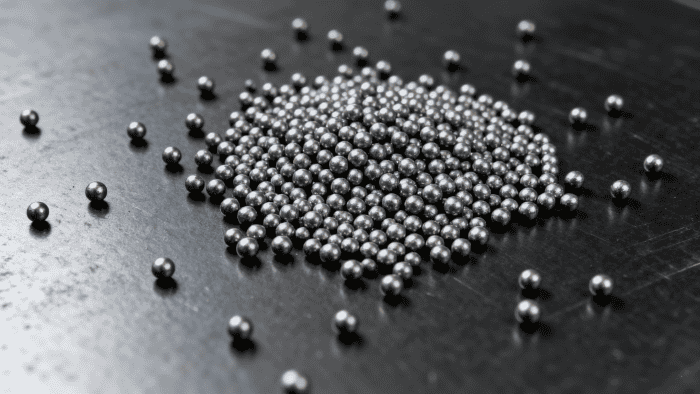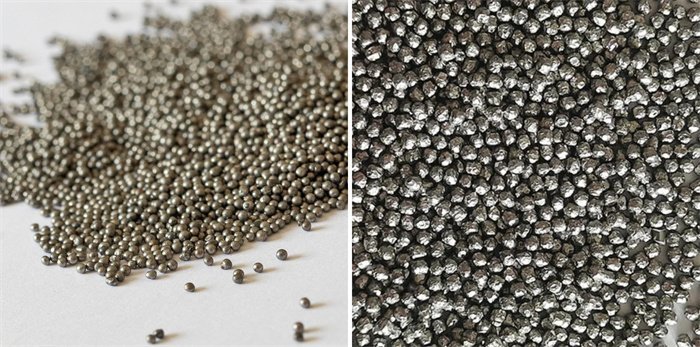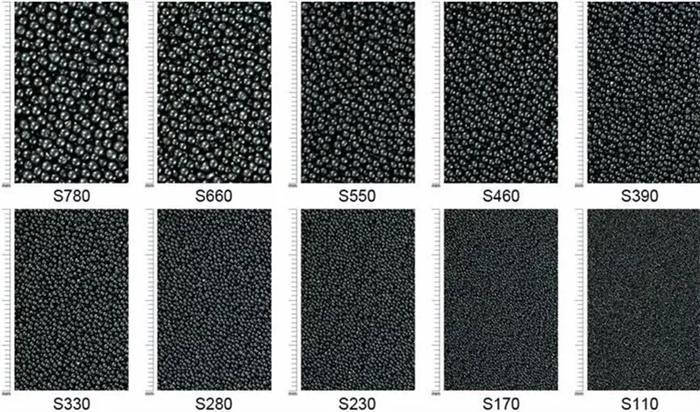
Steel shots are one of the most widely used metallic abrasives in the surface preparation and finishing industry. From cleaning castings to shot peening aerospace parts, different types of steel shots deliver distinct performance benefits. Understanding these differences helps industries select the right material for efficiency, quality, and cost savings.
Steel shots are spherical metallic abrasives, classified by material, hardness, and production process, with each type designed for specific industrial applications such as rust removal, shot peening, and surface finishing.
If you’re only looking for a quick definition, you now know what steel shots are. But if you want to make better sourcing or production decisions, keep reading — the differences between high carbon, low carbon, and stainless steel shots can directly affect your production costs and finished quality.
By exploring the various types of steel shots and their uses, you can optimize your blasting process and achieve consistent, reliable results.
Table of Contents
What Are Steel Shots?
Steel shots are small spherical metallic particles manufactured from steel scrap or wire, designed to be reused multiple times in blasting operations.
Steel shots are primarily used in shot blasting, surface cleaning, rust removal, shot peening, and decorative finishing.

Unlike angular abrasives like steel grit, steel shots provide a smoother and less aggressive impact. Compared with glass beads, they offer greater density, recyclability, and efficiency in demanding blasting operations.
Unlike disposable abrasives, steel shots can be recycled hundreds of times, making them cost-effective for large-scale industrial use.
How Are Steel Shots Classified?
Steel shots are not a single product but a broad category defined by several classification methods.
Steel shots are classified by material (carbon steel or stainless steel), hardness (40–60+ HRC), production process (cast/atomized or cut wire), and size (S70 to S930).
- By Material: High carbon steel shots, low carbon steel shots, 304 stainless steel shots, and 430 stainless steel shots. Each material offers different levels of durability, corrosion resistance, and cost efficiency.
- By Hardness: Soft (40–50 HRC), medium (50–60 HRC), and hard (60+ HRC). Hardness is measured on the Rockwell C scale (HRC) and directly influences cleaning aggressiveness and surface finish.
- By Process: Cast/atomized steel shots or cut wire shots. Cut wire shots can be further divided into as-cut, conditioned, and special conditioned grades, each providing different levels of roundness and durability.
- By Size: Steel shots are manufactured from S70 (fine) to S930 (coarse), following SAE J444 standards. Smaller sizes are used for smooth finishes, while larger sizes are chosen for heavy-duty descaling and surface preparation.
By mastering these four classification dimensions, buyers can confidently select the steel shot that best balances durability, cost, and application needs.
Classify Steel Shots by Material
One of the most practical ways to understand steel shots is by looking at their material composition. Different alloys bring different levels of hardness, corrosion resistance, and durability — all of which influence performance and cost-effectiveness.
Steel shots by material include high carbon steel shots, low carbon steel shots, and stainless steel shots (304 and 430), each designed for specific blasting and peening needs.
| Material Type | Key Features | Advantages | Typical Applications |
| High Carbon Steel Shot | Hardness 40–65 HRC, high resilience | Long service life, strong impact force, high cleaning efficiency | Foundries, steel mills, rust and scale removal |
| Low Carbon Steel Shot | Hardness 35–50 HRC, softer impact | Lower breakage, reduced dust, more economical | Surface cleaning of softer metals, routine blasting |
| Stainless Steel Shot 304 | High nickel content, excellent corrosion resistance | Prevents contamination, leaves bright finish, recyclable many times | Non-ferrous metals, aluminum, zinc, medical & food-grade stainless steel |
| Stainless Steel Shot 430 | Ferritic stainless, chromium-based, lower cost than 304 | Good rust resistance, cost-effective option | Decorative stainless steel finishing, stainless steel fabrication |
Choosing the right material type ensures not only optimal blasting results but also long-term cost savings by minimizing wear, contamination, and replacement frequency.
Classify Steel Shots by Hardness
Hardness is one of the most important factors when selecting steel shots. It directly affects the aggressiveness of the blasting action, the depth of the surface profile, and the service life of the abrasive. Different hardness levels are used to balance cleaning power with durability.
Steel shots are commonly divided into soft (40–50 HRC), medium (50–60 HRC), and hard (60+ HRC), with each grade offering distinct blasting performance and surface finish results.
Comparison Table
| Hardness Range (HRC) | Characteristics | Advantages | Typical Applications |
| Soft (40–50 HRC) | Less aggressive impact, reduced substrate stress | Longer lifespan, lower breakage rate | Cleaning softer metals, aluminum and non-ferrous components |
| Medium (50–60 HRC) | Balanced hardness with versatile performance | Good durability, effective cleaning power | General-purpose blasting, foundries, steel structures |
| Hard (60+ HRC) | High impact force, sharp cleaning effect | Rapid rust, scale, and coating removal | Heavy-duty blasting, shipbuilding, pipelines, thick coatings removal |
By matching the right hardness level to your workpiece and blasting goal, you can maximize efficiency, protect the base material, and extend the service life of your abrasive.
Classify Steel Shots by Production Process
Besides material, the way steel shots are manufactured also defines their shape, roundness, durability, and overall cost-performance ratio. The production process determines how consistently the shots perform under blasting conditions and how long they can be recycled before replacement.
Steel shots by process include cast/atomized steel shots and cut wire shots (as-cut, conditioned, and special conditioned), each offering different levels of durability, cost, and application suitability.


Comparison Table
| Process Type | Shape / Roundness | Durability | Cost Level | Typical Uses |
| Cast / Atomized Steel Shot | Mostly spherical, may contain slight porosity | Medium lifespan | Low to medium | General blasting, rust & scale removal |
| Cut Wire Shot (As-Cut) | Cylindrical with sharp edges | Lower durability due to breakage | Medium | Aggressive cleaning, descaling heavy coatings |
| Cut Wire Shot (Conditioned) | Edges rounded through conditioning | Higher durability than as-cut | Medium to high | Balanced cleaning efficiency and reduced surface damage |
| Cut Wire Shot (Special Conditioned) | Fully rounded, uniform size and density | Longest lifespan, minimal breakage | Higher | Shot peening in aerospace, automotive, precision components |
Selecting the right production process ensures that steel shots deliver consistent performance, extend equipment life, and minimize overall blasting costs — whether the priority is heavy-duty cleaning or precision shot peening.
Classify Steel Shots by Size
Steel shots are manufactured in a wide range of sizes, typically defined by SAE J444 standards. The size of the shot directly impacts the surface finish and cleaning speed. Smaller shots create smoother finishes, while larger shots deliver more aggressive cleaning and deeper surface profiles.
Steel shots range in size from S70 (fine) to S930 (coarse), with smaller sizes used for precision finishing and larger sizes for heavy-duty descaling and surface preparation.

Comparison Table
| Size (SAE J444) | Approx. Diameter (mm) | Surface Effect | Typical Applications |
| S70 – S110 | 0.18 – 0.3 mm | Very fine, smooth finish | Precision cleaning, aerospace parts, shot peening |
| S170 – S280 | 0.4 – 0.7 mm | Balanced cleaning and finish | Automotive components, general steel structures |
| S330 – S390 | 0.85 – 1.0 mm | Strong cleaning force | Foundries, descaling forged and cast parts |
| S460 – S660 | 1.2 – 1.7 mm | Aggressive blasting, deep profile | Shipbuilding, construction steel, pipelines |
| S780 – S930 | 2.0 – 2.5 mm | Very aggressive, coarse finish | Heavy-duty rust removal, large steel fabrications |
Note: Diameter ranges are common reference values and may vary slightly under different standards.
Choosing the correct shot size ensures you achieve the desired balance between cleaning power and surface finish quality — small shots for precision and smoothness, large shots for heavy-duty cleaning and rough profiles.
Applications of Different Steel Shots
Steel shots are versatile abrasives widely used across multiple industries. Each type — whether high carbon, low carbon, or stainless steel, and whether soft, hard, or conditioned — is tailored to deliver specific results. Applications range from heavy-duty descaling in shipyards to precision shot peening in aerospace.
Steel shots are applied in industries such as automotive, aerospace, shipbuilding, foundries, construction, and stainless steel fabrication for cleaning, shot peening, rust removal, and decorative finishing.
Comparison Table
| Application Area | Steel Shot Type | Purpose / Benefit |
| Surface Cleaning | High carbon or low carbon steel shots | Removes rust, scale, and sand from castings and forgings |
| Shot Peening | Special conditioned cut wire, medium-to-hard steel shots | Enhances fatigue strength in aerospace and automotive parts |
| Rust & Scale Removal | Hard, large-size steel shots (S460–S930) | Heavy-duty cleaning in shipbuilding, pipelines, bridges |
| Automotive Industry | Medium hardness steel shots, conditioned cut wire | Cleans engine blocks, gears, and springs with consistent finish |
| Aerospace Industry | Special conditioned stainless or cut wire shots | Provides precise peening for turbine blades and landing gear |
| Non-Ferrous Treatment | Stainless steel shots (304, 430) | Prevents contamination when cleaning aluminum, zinc, or stainless steel |
| Decorative Finishes | Stainless steel 304 & 430 | Produces bright, uniform finish for cookware, panels, medical devices |
By aligning the right steel shot with the correct application, industries achieve not only effective surface treatment but also extended component life, reduced maintenance costs, and higher product quality.
How to Choose the Right Steel Shot?
With so many material types, hardness grades, production processes, and sizes available, choosing the right steel shot can feel overwhelming. However, a structured approach ensures that you select an abrasive that balances efficiency, cost, and surface quality.
The right steel shot is chosen based on the workpiece material, required surface profile, blasting equipment, application purpose, and cost-performance balance.

- Workpiece Material:
- Non-ferrous metals (aluminum, zinc, stainless steel) → Stainless steel shots (304/430) to avoid contamination.
- Ferrous castings and forgings → High carbon or low carbon shots.
- Desired Surface Profile:
- Smooth finish → Smaller sizes (S70–S230), softer hardness.
- Rough finish / heavy cleaning → Larger sizes (S390–S930), harder shots.
- Blasting Equipment:
- Wheel blast machines perform best with spherical cast shots.
- Air blast systems may benefit from cut wire shots for precise peening.
- Application Purpose:
- Cleaning → General-purpose carbon steel shots.
- Shot Peening → Special conditioned cut wire shots for fatigue resistance.
- Decorative Finishing → Stainless steel shots for bright surfaces.
- Cost vs. Performance:
- Low carbon shots → Economical, less dust.
- High carbon shots → Longer lifespan, stronger impact.
- Stainless shots → Higher cost, but prevent contamination and reduce rework.
By carefully considering material, hardness, process, size, and application needs, you can select a steel shot that maximizes efficiency, minimizes waste, and ensures consistent surface quality.
Conclusion
Steel shots may appear simple at first glance, but their variations in material, hardness, production process, and size make a significant difference in performance and cost-effectiveness. By understanding these differences, industries can select the right abrasive for tasks ranging from heavy-duty descaling to precision shot peening.
In summary:
- By Material: High carbon, low carbon, and stainless steel (304 & 430) each have unique strengths.
- By Hardness: From soft (40–50 HRC) to hard (60+ HRC), hardness defines aggressiveness and finish.
- By Process: Cast/atomized or cut wire (as-cut, conditioned, special conditioned) affects shape and durability.
- By Size: S70–S930 determines surface smoothness vs. cleaning power.
- By Application: Matching shot type to industry needs ensures cost savings, efficiency, and product quality.
